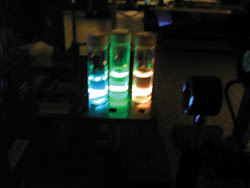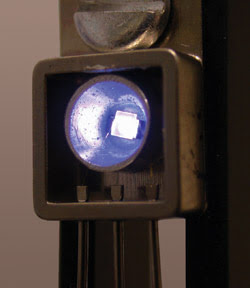Jeff Tsao, Mary Crawford, Jess Wilcoxon and Jerry Simmons, Sandia National Laboratories
For years, semiconductor technologies have dominated applications of light sources in the infrared region. For example, fiber communications makes use of light in the mid-IR range (1700 to 980 nm), and CDs and DVDs use light in the near-IR to deep red (800 to 650 nm). In both cases, semiconductors offer a low price/performance ratio that thus far remains unmatched.
Applications for light sources in the visible and ultraviolet wavelength regions, however, still are dominated by traditional technologies based on incandescent and gas-discharge lamps. This is ironic, because much of the early pioneering work in semiconductor optoelectronics focused on visible-light emission. Who knew that technologies in the visible and UV would prove so much more difficult than those in the IR?
All this may soon change. Breakthrough advances in technology promise to put semiconductor light sources at the heart of visible and UV applications, just as they already are for IR applications. Visible- and UV-emitting GaN-based materials, historically much lower in performance than IR- and deep-red-emitting GaAs- and InP-based materials, are within striking distance. Emission power has increased, wavelengths have broadened to fill the visible range and to enter the ultraviolet, and costs are coming down tremendously.
The result is a group of emerging semiconductor technologies that promises to revolutionize applications for light sources in the visible and ultraviolet:
Color LEDs. Monochromatic visible-wavelength LEDs already easily undercut their traditional, filtered-incandescence competition in the cost of life ownership (dollars per lumens per hour). As a result, they are well on their way to displacing that competition in virtually every application that requires such light: traffic signals, large outdoor television displays, automotive rear and interior lighting, and RGB backlights for liquid crystal displays.
White LED/phosphor hybrids. Starting with a monochromatic blue or near-UV LED, phosphor down-conversion can be used to produce broadband white light. This approach to white light for general illumination applications is likely to undercut traditional incandescent lamps in life ownership cost, with comparable color rendering, within the next few years.
Along the way, however, two significant challenges must be overcome: the development of more efficient near-UV LEDs and of efficient phosphors that absorb in the near-UV and emit at wavelengths optimally matched to the human eye’s sensitivity. For example, we at Sandia National Laboratories are developing nanocluster phosphors whose absorption and emission can be independently tuned through size engineering and surface treatments (Figure 1).

Figure 1. Three vials of CdS-based nanoclusters are excited by 365-nm radiation and subsequently emit blue, green and red light. Nanoclusters represent a potentially new generation of phosphors for the down-conversion of near-UV into broadband white light.
White LEDs from RGB mixing. A mixture of monochromatic (e.g., red, green and blue) LEDs also can produce broadband white light. This approach to general illumination applications does not suffer from the losses in efficiency associated with phosphor down-conversion, so it has the potential to undercut even traditional fluorescent lamps in life ownership cost. This would represent what is sometimes considered the ultimate lighting source: one nearly twice as efficient as fluorescent lamps but with half the life ownership cost.
One outstanding challenge is filling the spectral hole in the yellow-green region, within which light emission efficiency becomes very low. At Sandia and at many other laboratories, there is intense interest in studying the high-indium-content InGaN alloys that show the most promise for filling that hole.
Purple/UV lasers. Lasers for optical storage gradually will migrate to the purple and the near-UV because shorter wavelengths enable greater areal bit densities. Purple GaN-based lasers with the necessary performance characteristics are poised to power the coming generation of high-density DVDs. A major challenge, further into the future, will be the development of UV lasers suitable for a subsequent generation of ultrahigh-density DVDs.
UV LEDs. Monochromatic UV LEDs are much less mature than their visible counterparts, but they also are making rapid progress. Some of their envisioned applications are fluorescence-based bioagent detection and monetary-note verification, purification of microbe-contaminated water, nonline-of-sight covert communications, materials curing (e.g., inks, epoxies and adhesives) for dentistry and other uses, and medical/cosmetic (e.g., acne) skin treatments.

Figure 2. A packaged flip-chip-bonded deep-UV LED (1 × 1-mm die) offers CW power levels in themilliwatts range.
For some of these applications, shorter wavelengths are preferable. Sandia and other laboratories, sponsored by a Defense Advanced Research Projects Agency program, recently demonstrated milliwatt continuous-wave power levels at wavelengths as short as 276 nm (Figure 2). However, an outstanding challenge for these technologies is understanding and controlling the high-aluminum-content AlGaN alloys that show the most promise for such devices.
Meet the authors
Jeff Tsao ([email protected]), Mary Crawford ([email protected]) and Jess Wilcoxon ([email protected]) are members of the technical staff, and Jerry Simmons ([email protected]) is solid-state lighting program manager, at Sandia National Laboratories in Albuquerque, N.M.